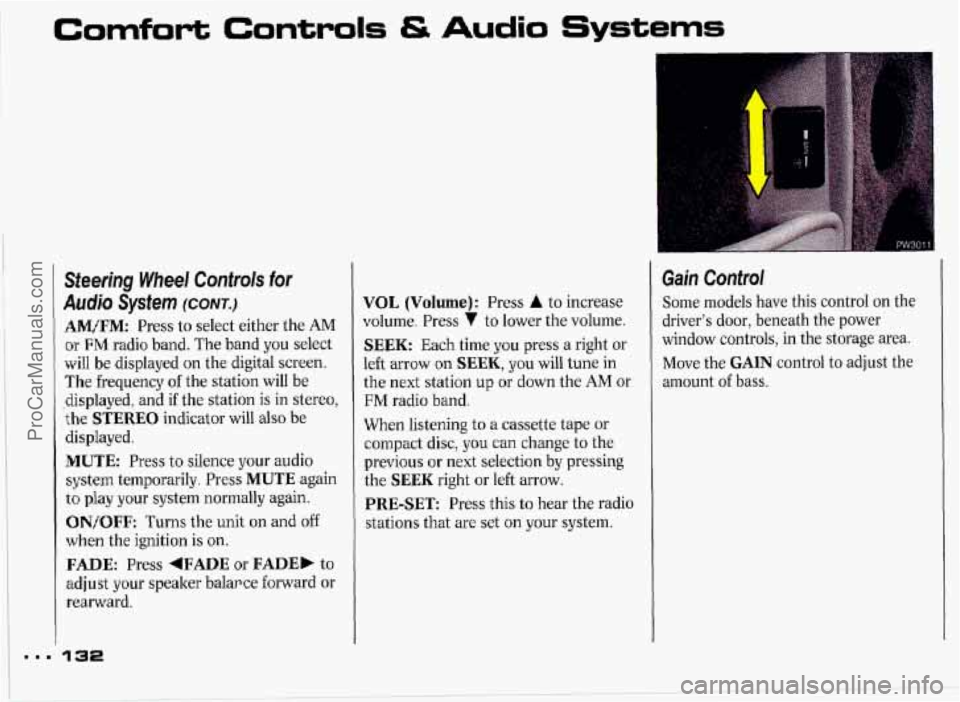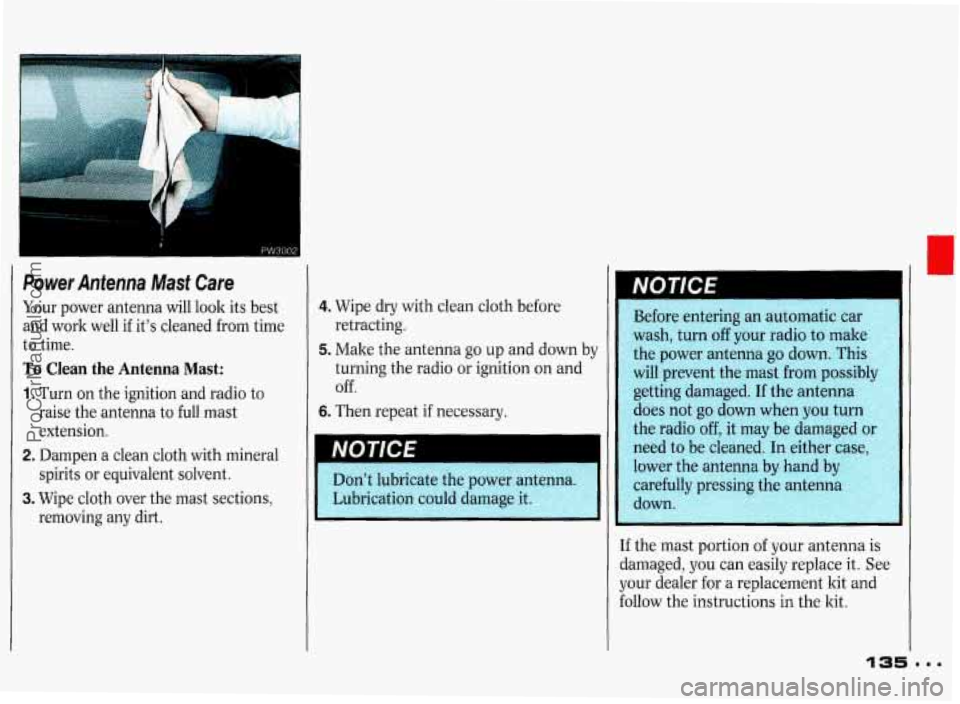1993 PONTIAC GRAND-PRIX ignition
[x] Cancel search: ignitionPage 133 of 338

Comfort Controls & Audio Systems
Steering Wheel Controls for
Asrdjo Sysfem (CONT.)
AMflM: Press to select either the AM
or FM radio band. The band you select
will be displayed on the digital screen.
The frequency of the station will be
-displayed, and
if the station is in stereo,
the
STEREO indicator will also be
displayed.
MUTE: Press to silence your audio
system temporarily. Press
MUTE again
to play your system normally again.
l ON/OFF: Turns the unit on and off
when the ignition is on.
FADE: Press +FADE or FADE, to
adjust your speaker balar ce forward or
rearward.
VOL (Volume): Press A to increase
volume. Press
7 to lower the volume.
SEEK: Each time you press a right or
left arrow
on SEEK, you will tune in
the next station up or down the AM or
FM radio band.
When listening to
a cassette tape or
compact disc, you can change to the
previous or next selection by pressing
the
SEEK right or left arrow.
PRE-SET Press this to hear the radio
stations that are set
on your system.
Gain Control
Some models have this control on the
driver's door, beneath the power
window controls, in the storage area.
Move the
GAIN control to adjust the
amount
of bass.
ProCarManuals.com
Page 136 of 338

Power Antenna Mast Care
Your power antenna will look its best
and
work well if it's cleaned from time
to time.
To Clean the Antenna Mast:
1. Turn on the ignition and radio to
raise the antenna
to full mast
extension.
spirits or equivalent solvent.
removing any dirt.
2. Dampen a clean cloth with mineral
3. Wipe cloth over the mast sections,
4. Wipe dry with clean cloth before
retracting.
5. Make the antenna go up and down by
turning the radio or ignition on and
Off.
6. Then repeat if necessary.
NOTICE
If the mast portion of your antenna is
damaged,
you can easily replace it. See
your dealer for a replacement kit and
follow the instructions in the kit.
ProCarManuals.com
Page 169 of 338

your Driving and the Road
-1
HM and Mountain Roads
Driving on steep hills or mountains is
different fiom driving in flat or rolling
terrain.
If you drive regularly in step
country, or if you’re planning to visit
there, here are some tips that can make
your trips safer and more enjoyable.
* Keep your vehicle in go’od shape.
Check all fluid levels and also the
brakes, tires, co’oling system and
transaxle. These
parts can work hard
~n mountain roads.
. K~QW how to go, down hills. The most
important thing
to how is this: let
your engine do some of the slowing
down. Don’t make your brakes do it
an.. Shift to a lower gear when YQU go
down a steep or long hill. That way,
you will slow down without excessive
use of your brakes.
168
If you don’t shift down, your
brakes could get
so hot that
they wouldn’t work well. You
would then have poor braking or
even none going down a hill.
You
could crash. Shift down to let your
engine assist your brakes on a steep
downhill slope.
I
A Coasting downhill in
- N (Neutral) or with the
* ignition off is dangerous. Your
akes will have
to do all the work
slowing down. They could get
so
riot that they wouldn’t work well.
You could crash. Always have your
Pngine running and your vehicle in
a-ar when you
go downhill.
Know how to go uphill. You may
want to shift down to a lower gear.
The lower gears help
cool your engine
and transaxle, and you can climb the
hill better.
Stay in your own lane when driving
on two-lane roads in hills or
mountains. Don’t swing wide or cut
across the center
of the road. Drive at
speeds that let you stay in your own
lane. That way, you won’t be ’ surprised by a vehicle coming toward
you in the same lane.
It takes longer to pass another vehicle
when you’re going uphill. You’ll want
to leave extra room to pass. If a
vehicle is passing you and doesn’t
have enough room, slow down to
make it easier for the other vehicle to
get by.
ProCarManuals.com
Page 187 of 338

Problems on the Road
2. Get the vehicles close enough so the 3. Turn off the ignition on both
jumper cables can reach, but be sure
the vehicles aren’t touching each
other.
If they are, it could cause a
ground connection you don’t want.
You wouldn’t be able to start your
Pentiac, and the bad grounding could
damage the electrical systems.
CAUTION I
You could be injured if the
b vehicles roll. Set the parking
brake firmly on each vehicle. Put an
automatic transaxle in
P (Park) or a
manual transaxle in N (Neutral).
4. Open the hoods and locate the
vehicles. Turn
off all lights that aren’t batteries.
needed, and radios. This
will avoid
sparks and help save both b’atteries.
1, CAUTION
And it could save your radio!
II
If you leave your radio on, it could
be badly damaged. The repairs
wouldn’t be covered
bv your --
warranty.
I
~~~~~~~~~~~~~~~~~,~~~~~~~~~~~~~ ij Find the positive (+) and negative (-)
terminals on each battery. Your Pontiac
has a remote positive
(+) jump starting
terminal. The terminal is on the same
side
of the engine compartment as your
battery.
You should always
use the remote
positive
(+) terminal instead of the
positive
(+) terminal on your battery.
To uncover the remote positive
(+)
terminal, lift the red plastic cap.
ProCarManuals.com
Page 191 of 338

Problems on the Road
Towing Your P onfiac (c0N;T.j
When your vehicle is being towed!, have
the ignition key
off. The steering wheel
should be clamped
in a straight-ahead
position, with a clamping device
designed for
towing service. Do not use
the vehicle's steering
column lock for
this. The transaxle should be in
N [Neutral) and the parking brake
re1,eased.
Don't have your vehicle towed
on the
front wheels, unless
you must. If the
vehicle must be towed
on the front
wheels, don't go more than 35 mph
(56 km/h) or farther than 50 miles
(80 km) or your transaxle will be
damaged. If these limits must be
exceeded, then the front wheels have to
be supported on a dolly.
II
CAUTION
* A vehicle can fall from a car
scb,red. This can cause a collision,
serious personal injury and vehicle
damage. The vehicle should be
tightly secured with chains or steel
cables before it is transported.
Don't use substitutes (ropes,
leather straps, canvas webbing,
etc.) that can be cut
by sharp e('- :s
underneath the tou hicle .
I b carrier if it isn't properly
Towing from the Front-
Vehicle
Hook-up
Before hooking up to a tow truck, be
sure to read all the information on
Towing Your Pontiac earlier in this
section.
1. Attach T-hook chains into the side
slots in the cradle in front of the
wheels, on both sides.
ProCarManuals.com
Page 274 of 338

Fuse Rating
(AMP-)
1 20
2
15
3 20
4
5
6
-7
8
9
10
11
10
10
15
10
Circuitry
AIR Pump (3.4L Manual)
Trunk Release, Back-up Lights (Auto)
ECM; Fuel
Pump
Not Used
Not Used
Not Used
Direct Ignition System
Fuel Injectors
Not Used
A/C Coil, Secondary Cooling Fan, Generator, Digital EGR,
Purge Canister, Back-up Lights
(3.4L Manual)
Primary Cooling Fan
(3.1L); TCC; AIR Pump (3.4L Manual)
Relay Rating Circuitry
(MAP.)
12 Fuel Pump
13 AIR Pump (3.4L)
14
Secondary Cooling Fan
15 Primary Cooling Fan
16 A/C Clutch Coil
Fusible Elements
17 60 Starter Solenoid
18 30 Cooling Fan (3.1L)
60 Cooling Fan (3.4L}
19 60 Blower Motor
20
60 Cooling Fan
21
30 Fuse Block
I
273 =
ProCarManuals.com
Page 330 of 338

Filling Your Tank .................. 215. 277
Fuels with Alcohol
......................... 213
Gage
................................................ 97
In Foreign Countries
...................... 214
Requirements
................................ 213
Fuels in Foreign Countries
............... 214
Low Fuel Warning Light
.................. 98
Fuses & Circuit Breakers ................ 270
Gages Coolant Temperature
...................... 99
Fuel
................................................... 97
Voltmeter
....................................... 102
Gain Control
..................................... 132
Gas Station Information
................. 336
Gasoline ............................................ 213
Gasoline Tank,
Filling Your
........................... 215, 277
Gear Positions (see
Shifting the
Transaxle)
Gearshift Lever
(see
Shifting the Transaxle)
Glove Box ........................................... 50
Graphic Equalizer (see Audio Systems)
Halogen Bulbs ....................... 237. 280
HazarYd Warning Flashers
................. 184
Headlights
........................................... 78
Headlight
& Taillight. Removing
and
Replacing
....................... 239. 244. 280
Aim. Adjusting
............................... 238
Aim. Checking
............................... 237
Flash-to-Pass
.................................... 80
High-Low Beam Changer ............... 79
“On” Reminder ................................ 78
Replacement
........................... 239, 244
Replacement Bulbs ....................... 280
Wiring
............................................. 275
Head Restraints
.................................. 13
Head-Up Display (HUD) ................ 110
Heater
............................................... 117
Heater, Engine Block ................. 56, 223
High Beams
............................... 79, 158
Highway Hypnosis .......................... 167
Hill and Mountain Roads
................ 168
Hills, Parking on .............................. 169
Hood Release
.................................... 216
Safety Warning
.............................. 217
Warning, Overheated Engine
....... 195
Hearing or
Speech Impaired
............ 31 1
Horn ................................................... 69
Hot Engine.
Safety Warnings
..... 193. 195.217. 232
HUD (Head-Up Display) ................ 110
Hydraulic Clutch .............................. 229
Hydroplaning
................................... 161
Identification Engine
............................................. 269
Label. Service
Parts ....................... 269
Number. Vehicle (VIN Code)
....... 268
68
Sand. Mud. Ice or Snow 208
Key
................................................... 44
Positions ........................................... 52
Idling Your Engine
If You’re
Stuck: In
Ignition
.............................
...............
Indicator Lights (see Warning Lights)
Infant Restraint (see Child Restraints)
Inflation. Tires 255
Inside Rearview Mirror
............... 81. 83
Instrument Panel 92
Instrument Panel Clusters
................. 94
Instrument Panel Intensity Control
... 80
Instrument Panel Warning Lights ..... 95
.................................
...............................
ProCarManuals.com